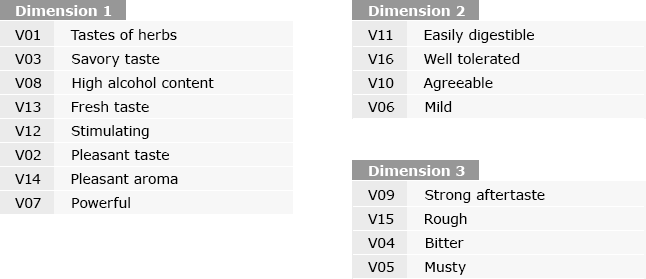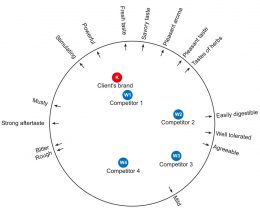Practical example: Multidimensional Scaling
Objective
A spirits manufacturer wished to plan the optimal positioning of one of his products – an herb liqueur – within the competitive environment. With this in mind, a tracking study was put in place to monitor specific changes in the product over a long period. In a qualitative phase, 16 items were defined and their validity with regard to the objective was checked by means of a factor analysis; see „Identifying fundamental dimensions“.
The factor analysis showed that the items could be clearly classified into the three fundamental rating dimensions, “taste / effect”, “tolerability” and “disturbance”.
In the following tracking waves, all tested products were rated on these 16 items. Thus, for each wave the positioning of the client’s product could be shown in detail in relation to the competitor products.
A tabulation of the positioning of the client’s product in an environment with 4 competitor products delivered 80 median scores (5 x 16). A comparison of all brands for the 16 items on a paired basis alone would require 160 mean score comparisons. To obtain an overall picture of the positions, much more complex comparisons would be required. Thus it would hardly be possible to understand such an overall picture on a cognitive basis alone.
Therefore, the use of tables is always a jigsaw puzzle with a multiplicity of small pieces which can never be put together into a single unit.
A true graphical presentation should depict all the interrelations between brands and features – thus simplifying the identification and interpretation of positions in the competitive environment.
Analysis
To create this graphical presentation, a multidimensional scaling (MDS) was used.
The following 16 characteristics were rated:

Ratings were on a 7-point scale, where 1 = “does not apply at all” and 7 = “applies completely”.
The multidimensional scaling of the data from the first wave delivered the following result:
It can be seen that the 5 liqueurs were perceived differently by the survey respondents. The client’s product (Product K) has a distinct position. However, on the basis of the learnings from the previously-conducted factor and regression analyses, it must be concluded that this position is not unambiguously positive. Product K is rated very positively for the items in the “taste / effect” group (see „Identifying fundamental dimensions“). Because of the strong positive influence of this dimension on willingness to buy this (see “Determining influences on the buying decision”) guarantees a high level of acceptance among the target group.
However, when comparing with competitors 1 and 2, it is easy to see the weaknesses of Product K. Products W1 and W2 are also positively rated on “taste / effect”. Moreover, they are rated significantly better with regard to the factor of “tolerability”, which is also a very strong driver. In addition, Product W2 is particularly perceived as substantially less irritating (lower “disturbance” factor).
It is thus clear that a repositioning towards “upper right”, i.e. in the direction of “tolerability” – if possible without any loss of “taste / effect” – would mean an optimization with regard to consumer acceptance. In addition, it would position the product in a niche, because none of the competitors’ products are both very tasty / effective and also tolerable.
It may be the case that such a constellation is very difficult to achieve, or only at great cost. However, the consideration of the costs and benefits of such a change is made considerably easier and better substantiated when viewed in relation to the combined presentation of all the fundamental aspects.
The MDS under consideration reflects the findings from the factor analysis. The three independent dimensions discovered in the factor analysis can evidently be projected well onto a plane. This is a special case, allowing the two analyses to be linked and thus simplifying interpretation.
It is not always possible to project such independent dimensions clearly on a plane. In principle, more than three independent dimensions cannot be depicted accurately in a two-dimensional plane. Therefore it is not meaningful to use independent factors for an MDS.
In the case under discussion, all the depicted features and brands could be projected on a plane in such a way that the relations between them were accurately reflected. However, the Figure does not include all 16 rated items. The item “high alcohol content” had to be eliminated, because its projection on the plane would lead to an inaccurate depiction and thus to the danger of misinterpretation.
All of the remaining 15 items could be reproduced in the two-dimensional space with an accuracy of at least 67% (two-thirds explained variance).


